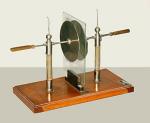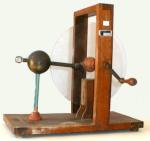- Insulated cylindrical conductor
- Faraday‘s hood or electric screen
- Electric chimes
- Small electric fly
- Leyden jar, may be taken to pieces
- Aepinus capacitor
- De la Rive electric egg
- Electrostatic machine of the Winter type
- Electrostatic machine of the Wimshurst type
- Voltaic pile
- Grenet’s pile
- Accumulator
- Mariner’s compass with Cardan’s suspension
- Summary


 Menu
Menu












